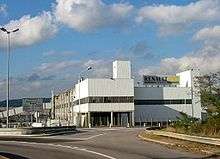Sandouville Renault Factory
| Built | 1964 |
|---|---|
| Location | Sandouville, France |
| Coordinates | 49°29′05″N 0°17′47″E / 49.484799°N 0.296495°ECoordinates: 49°29′05″N 0°17′47″E / 49.484799°N 0.296495°E |
| Industry | Automotive |
| Area | 237 hectares |
| Address | Route Alizés, 76430 Sandouville, France |
The Sandouville Renault Factory is a car plant belonging to the Renault Group, established in 1964 at Sandouville in the Seine-Maritime department, not far from the port of Le Havre. Work began on its construction in July 1963 and the factory was in most respects completed by December 1964.[1]
Initially it was constructed for the assembly of the Renault 16 which was formally launched in March 1965 at the Geneva Motor Show, but not available for sale, even in its home market, till June 1965.[1] Initially the plant, which enjoyed excellent communication links, notably by rail and river, focused on final assembly, while most of the sub-assemblies and other components arrived from older Renault plants located along the River Seine between Le Havre and Paris.[1] For the early Renault 16s running gear and suspension sub-assemblies came from the company's old Billaincourt factory.[1] Also on the banks of the Seine is Cléon from where another Renault plant supplied Sandouville with power trains.[1] Flins supplied Sandouville with stampings and chromed components.[1]
Subsequent models built at Sandouville include the Renault 17, Renault 20, Renault 30, Renault 18, Renault 21, Renault 25, Renault Safrane, Renault Laguna and Renault Vel Satis, meaning that of the three major Renault plants in France, this is the one that concentrates on the larger models. Since 2003, when the Renault Espace switched from a composite body shell (manufactured on Renault's behalf by Matra) to a more conventional pressed steel body shell, the Espace has also been manufactured at Sandouville.
At its peak, the plant employed 12,000 people, but by 2006 this had fallen to just 4,650. Since the Second World War Renault traditionally concentrated on smaller cars, and many of the company's middle-weight and larger models have encountered difficulty establishing significant market share against competitor offerings. Employees looked to the Renault Laguna III, launched at the end of 2007, for an upturn in their prospects. Le Monde on 30 September 2006 reported Renault as saying that if the Laguna III, intended to revive Sandouville's fortunes, failed to take off in the market place, there would be [adverse] consequences for a site currently operating at only 40% of its design capacity. (« Si la première voiture que l'on essaie de faire revivre à Sandouville ne marche pas, cela aura des conséquences pour ce site qui ne tourne déjà qu'à 40 % de ses capacités. Notre plan est réaliste, mais pas idéaliste. » [2])
The new Laguna was not an instant hit with customers, and in July 2008 Renault announced that one of the two work teams would be cancelled, which would involve about 1,000 of the workforce.[3] On 12 June 2014 Renault announced it would move the production of the third-generation Trafic and the high-roof version of the Opel/Vauxhall Vivaro from Luton to Sandouville.[4]
As of 2014 the Sandouville plant is producing the following models:
- Renault Laguna III ( Berline, Break, Coupé )
- Renault Espace IV ( short- and long-wheelbase versions )
- Renault Trafic III
Sources
- 1 2 3 4 5 6 Bellu, René (2003). "Toutes les voitures françaises 1965 (salon Paris, Oct 1964)". Automobilia. Paris: Histoire & collections. 25: 71.
- ↑ Le Monde, 30 septembre 2006
- ↑ "Marché en crise, marges en hausse : Renault liquide 5.000 emplois". Libération. 24 July 2008. News report 24 July 2008
- ↑ "Sandouville: new plant, New Trafic and 50 years of excellence". Renault. 12 June 2014. Retrieved 16 June 2014.
